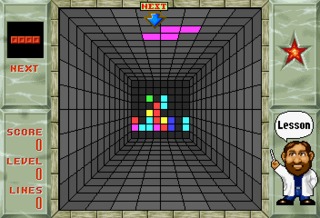Overview

Welltris is a falling-block puzzle game developed by Sphere for Bullet-Proof Software and published by both Spectrum Holobyte (in North America) and Infogrames (in Europe) for MS-DOS PCs, Macintosh, and Amiga computers in 1989-1990.
Designed by Alexey Pajhitnov and Andrei Sgenov (the former previously known for Tetris) from the company Doka, Welltris has players maneuvering polyominoes down the edges of a three-dimensional, well-shaped, cubic playfield in order to form complete lines between opposite walls. Similar to Spectrum Holobyte's release of Tetris, it features a heavy Soviet theme.
The game was also ported by Infogrames for Amstrad CPC, Atari ST, and ZX Spectrum computers in 1990, all released exclusively in Europe. It was also ported by Video System for arcades in 1991, and was later ported by Tose to NEC PC-98 computers for Japan on March 27, 1992.
Gameplay
Players take control of multiple polyominoes (varying in both shape and size) down the inner edges of a cubic playfield (with a 8×8 floor and four 8×12 walls) in order to form a straight line of tiles between opposite walls (which clears those tiles from the playfield).
Each piece can be moved along the walls of the playfield and be rotated counter-clockwise as they're falling. The game includes two Move Modes: one where the movement keys depend on the wall the piece is in (Left/Right for the top and bottom walls, Up/Down for the left and right walls) and one where the movement keys always cycle the piece in the clockwise (left) or counter-clockwise direction (right). When the piece reaches the floor, it continues moving along the floor in the same direction (where it can only be rotated) until it hits either another tile or the opposite wall. It's possible for the piece to fall in two separate walls (using corners), which splits the piece when it reaches the floor. Players can also hard-drop the piece to make it uncontrollably fall faster.
When lines are cleared, all tiles on either side of the line (in the direction of the closest edge) shift towards the cleared line, even moving tiles stuck on the wall towards it.
When a tile fails to enter the floor, it sticks up on the wall and temporarily "locks" the wall, preventing players from moving pieces onto that wall for three turns. Afterwards, the locked tiles fall down into the playfield. The game ends when all four walls are locked at once.
Arcade Version
The game's arcade release includes a few differences from the original, namely with the way locked walls work. Rather than locking an entire wall temporarily, each tile stuck on the wall shrinks the height of all walls and clears itself from the playfield, making it more difficult to maneuver pieces. The walls also shrink over time, and can only expand back outward by clearing lines. The game ends when no tiles can be entered.
The arcade version also includes two-player versus multiplayer, which happens on the same playfield. Player 1 only has access to the left and bottom walls, while Player 2 only has access to the right and top walls. Rather than shrinking all walls, it shrinks only the walls of the player who dropped the piece. Clearing a line only expands the walls back for the player who cleared the line.
In addition, this version of the game uses the second Move Mode and allows players to move the pieces while its sliding across the floor.
Log in to comment